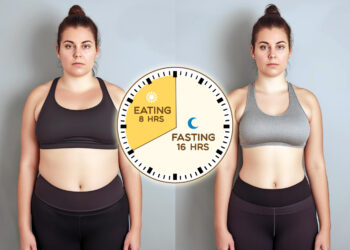Many people consider their waist size to be the leading fitness indicator. If they see a bulging belly, they know they need to start working on their fitness. On the other hand, a retracting waistline is a cause for celebration for overweight folks.
“What is the average waist size for women?” or “What is the average waist size for men?” is usually the most common question amongst people who are beginning to take control of their diet and physical fitness. However, contrary to popular opinion, the average waist size might not be the ideal waist size for them. But why is that, you ask?
Every individual is different and has a unique body composition and structure. Furthermore, the average waist size of a person varies with their gender, age, and height.
To put it briefly, you should not expect a six-foot-two, 55-year-old man to have the same waist size as a five-foot-five, 25-year-old female, or even a five-foot-five, 25-year-old male, for that matter.
However, you shouldn’t use this as an excuse to overlook your bulging waistline. As per a study in the Journal of the American Heart Association, waist size predicts heart attacks better than BMI, especially in women.
Additionally, visceral fat gathers deep around your abdominal area and surrounds the internal organs, which might result in health problems.
Level Up Your Fitness: Join our 💪 strong community in Fitness Volt Newsletter. Get daily inspiration, expert-backed workouts, nutrition tips, the latest in strength sports, and the support you need to reach your goals. Subscribe for free!
What is average waist size for Men & Women?
Recent data from the National Health and Nutrition Examination Survey (NHANES) reveals that the average waist circumference for adult men in the United States is approximately 40.5 inches (102.9 cm). In comparison, adult women have an average waist circumference of 38.7 inches (98.4 cm). These measurements provide valuable insights into the overall health and fitness levels of the population.
What is the average waist size for women?
According to a survey conducted by the National Center for Health Statistics on 5,065 female participants, the average waist size for women of all ages is 38.7 inches or 98.4 cm. [1]
As per the report, the average waist size of women changes by age, and younger women usually have smaller waists than older women. Females aged 20-29 have a 36.3-inch waist on average, and women aged 30-39 usually have a 38.3-inch waistline. That’s a two-inch gain in a 10-year span.
Furthermore, 39.2 inches is the average waist size for women in the 40-49 age bracket — almost an inch more than their counterparts in the 30-39 age group. Notably, there isn’t much change in a women’s waist circumference as she enters her fifties. In the 50-59 age bracket, an average female’s waist size is 39.3 inches.
The average female waist size peaks at 40 inches in the 60 to 79 age range. However, it recedes by 1.3 inches to 38.7 inches as a woman enters her 80s. [2]
| Age | Average Waist Size (inches) | Average Waist Size (cms) |
| 20-29 | 36.6 | 92.1 |
| 30-39 | 38.3 | 97.2 |
| 40-49 | 39.2 | 99.5 |
| 50-59 | 39.3 | 99.8 |
| 60-69 | 40.0 | 101.7 |
| 70-79 | 40.0 | 101.5 |
| 80+ | 38.7 | 98.3 |
What is the average waist size for a teenage girl?
In the U.S., the average waist size of a 13-year-old girl is 30.9 inches, which increases to 31.7 inches in their 14th and 15th year. However, this number budges to 32.4 inches for a 16-year-old.
A 17-year-old girl has an average waist size of 33.1 inches, but this number touches 33.5 inches as she enters adulthood at 18. At 19, the average female waist size is around 34.6 inches.
Notably, the overall average waist size for women in the US has increased from 37.4 inches in the 2010s to 38.7 inches in the 2020s.
Here is the average waist size for adolescent girls as per their age:
| Age | Average Waist Size (inches) | Average Waist Size (cms) |
| 2 | 18.9 | 48.0 |
| 3 | 19.8 | 50.3 |
| 4 | 20.9 | 53.0 |
| 5 | 22.0 | 55.9 |
| 6 | 22.5 | 57.1 |
| 7 | 23.9 | 60.6 |
| 8 | 24.8 | 63.1 |
| 9 | 25.6 | 65.0 |
| 10 | 27.6 | 70.0 |
| 11 | 28.8 | 73.2 |
| 12 | 30.2 | 76.6 |
| 13 | 30.9 | 78.5 |
| 14 | 31.7 | 80.6 |
| 15 | 31.7 | 80.4 |
| 16 | 32.4 | 82.2 |
| 17 | 33.1 | 84.2 |
| 18 | 33.5 | 85.2 |
| 19 | 34.6 | 88.0 |
What is the average waist size for men?
As per a US Anthropometric Reference Data survey conducted on 4,881 participants between 2015 and 2018, the average waist size for men aged 20 and above is 40.5 inches or 102.9 cms.
The average male waist circumference for a man aged 20-29 is 37.1 inches, and the number jumps to 40.4 inches for a man aged 30-39 and 41 inches for a man in the 40-49 age range.
The survey said that an average man between 50 and 59 years of age has a 41.4-inch waist. The average male waist circumference heads north to 42.2 inches for men in their 60s before peaking at 43.3 inches for men in their 70s. The average waist size for an average man drops a little more than a couple of inches to 41.1 when a male enters his 80s.
| Age | Average Waist Size (inches) | Average Waist Size (cms) |
| 20-29 | 37.1 | 94.2 |
| 30-39 | 40.4 | 102.6 |
| 40-49 | 41.0 | 104.1 |
| 50-59 | 41.4 | 105.1 |
| 60-69 | 42.2 | 107.3 |
| 70-79 | 42.3 | 107.4 |
| 80+ | 41.1 | 104.3 |
What is the average waist size for a teenage boy?
31.6 inches is the average waist size for a 13 to a 14-year-old teenage boy, and this number fluctuates routinely as the boy approaches adulthood.
Level Up Your Fitness: Join our 💪 strong community in Fitness Volt Newsletter. Get daily inspiration, expert-backed workouts, nutrition tips, the latest in strength sports, and the support you need to reach your goals. Subscribe for free!
For a 15-year-old teenage boy, 33.5 inches is the average waistline size. The number falls to 32.2 inches for a 16-year-old boy before hitting a new high at 33.7 inches for a 17-year-old.
However, the waist size of an average teenage boy drops slightly to 33.4 inches as he hits 18 before peaking at 35.2 inches after he turns 19. Here is the average waist size for adolescent boys as per their age:
| Age | Average Waist Size (inches) | Average Waist Size (cms) |
| 2 | 19.2 | 48.8 |
| 3 | 20.2 | 51.3 |
| 4 | 20.9 | 53.2 |
| 5 | 21.7 | 55.0 |
| 6 | 22.5 | 57.3 |
| 7 | 23.6 | 59.9 |
| 8 | 24.8 | 63.1 |
| 9 | 26.2 | 66.6 |
| 10 | 27.7 | 70.4 |
| 11 | 28.8 | 73.2 |
| 12 | 28.7 | 72.9 |
| 13 | 31.6 | 80.2 |
| 14 | 31.6 | 80.3 |
| 15 | 33.5 | 85.0 |
| 16 | 32.2 | 81.7 |
| 17 | 33.7 | 85.6 |
| 18 | 33.4 | 84.9 |
| 19 | 35.2 | 89.5 |
What is the ideal waist circumference by height?
As per research, your waist circumference should not be more than half of your height, meaning your waist-to-height ratio should not be more than 0.5. [3]
Note: This ratio is an upper limit and not the ideal waist-to-height ratio.
Per a WHO report, irrespective of a man’s height, his waist size should not be more than 37 inches. The same report recommends 31.5 inches as the safe waist circumference upper limit for women. However, the American Heart Association puts the figure at 40 inches for men and 35 inches for women.
| Height (in feet) | Ideal Waist Size (Women) (inches) |
| 4’11” | 29.5 |
| 5’1” | 30.5 |
| 5’2” | 31 |
| 5’3” | 31.5 |
| 5’4” | 31.5 |
| 5’5” | 32 |
| 5’6” | 31.5 |
| 5’7” | 31.5 |
How To Measure Your Waist Accurately?
Contrary to what most people think, your pant size is not your waist size. You could have a 40-inch waist even though you wear a size 36 pants. Here is how to measure your waist correctly:
- Stand upright with a shoulder-width stance.
- Place a tape measure around your ilium (your body’s middle). It should be between the bottom of your ribs and the top of your hips.
- Measure yourself with a natural-fitting measure. The tape shouldn’t be too tight or loose.
- Record the number on the tape.
Notes
- For best measure, repeat the process thrice and average the results.
- Do not suck in your gut while measuring your waist. Keep a neutral posture.
- Make sure your abdomen is clear of any clothing that might skew the measurement.
- While measuring the circumference of your waist, the tape measure should be parallel to the floor. It shouldn’t be slanting downward or upward.
Risks of Having a Large Waist Circumference
According to some studies, the risks associated with a waist circumference larger than 35 inches in women or 40 inches in men include: [4]
- High blood pressure
- Type 2 diabetes
- Certain types of cancer
- Cardiovascular disease
- Blood fat disorders
- Dementia
- Impaired pulmonary function
- Metabolic syndrome
- Glucose intolerance
- Insulin resistance and hyperinsulinemia
Other Health Measurements
While your waist size can help you assess your physical fitness level, it shouldn’t be viewed in isolation. Below are other health indicators you should keep in check:
1. BMI
Body Mass Index (BMI) is a rough measure of your body fat, which can be measured by dividing your weight by the square of your height. Sounds confusing? Use our convenient and free calculator to know your BMI.
Our calculator will also tell you if you’re in the underweight, normal weight, overweight, obese, or extremely obese category as per the BMI standards.
Here are the various BMI categories:
- Underweight: <18.5
- Normal weight: 18.5 – 24.9
- Overweight: 25 – 29.9
- Obesity: 30 – 34.9
- Extreme Obesity: 35 or greater
2. Weight-to-Hip Ratio
It describes how much weight you carry on your hips, thighs, and buttocks and is ascertained by dividing your waist measurement by your hip measurement.
A 2011 study found that waist circumference and waist-to-hip ratio have a more direct link to health conditions than BMI. [5]
FAQs
What are the health risks of larger than average waist size for women and men?
A 2015 study published in the Journal of Clinical Investigation found a connection between abdominal fat and increased risk of type 2 diabetes and heart disease in women and men with larger than average waist sizes.
What is considered a small waist in women and men?
A 31-inch waist and below is considered slim for a woman, and a 36-inch waist and below is considered small for a man.
What is the average UK waist size?
The average UK waist size is 35 inches for women and 38 inches for men, which is slightly lower than the average waistline in the US.
How to reduce your waist size?
You could reduce your waist size by following the steps laid down below:
- Determine your daily calorie intake goal as per your goal body weight.
- Follow a calorie deficit diet.
- Drink at least a gallon of water every day.
- Add LISS (low-intensity steady-state) or HIIT (high-intensity interval training) cardio to your routine.
Next Read: What Does a 40-inch Waist Look Like?
Wrapping Up
While your waist size alone is not enough to access your overall fitness levels, it can act as a cue for knowing when it’s time to make a greater investment in your physique.
According to the National Heart, Lung, and Blood Institute, a man with a waistline of more than 40 inches or a woman with 35 inches might be at an increased risk of hypertension (high blood pressure), heart disease, and type 2 diabetes. So, make sure your waist circumference is always under the limit while following a healthy lifestyle.
References
- Fryar CD, Carroll MD, Gu Q, Afful J, Ogden CL. Anthropometric reference data for children and adults: United States, 2015–2018. National Center for Health Statistics. Vital Health Stat 3(46). 2021.
- Fryar CD, Kruszon-Moran D, Gu Q, Carroll M, Ogden CL. Mean body weight, height, waist circumference, and body mass index among children and adolescents: United States, 1999–2018. National Health Statistics Reports; no 160. Hyattsville, MD: National Center for Health Statistics. 2021. DOI: https://dx.doi.org/10.15620/cdc:107559.
- Ashwell, M., Gibson, S. A proposal for a primary screening tool: `Keep your waist circumference to less than half your height’. BMC Med 12, 207 (2014). https://doi.org/10.1186/s12916-014-0207-1
- Ross, R., Neeland, I.J., Yamashita, S. et al. Waist circumference as a vital sign in clinical practice: a Consensus Statement from the IAS and ICCR Working Group on Visceral Obesity. Nat Rev Endocrinol 16, 177–189 (2020). https://doi.org/10.1038/s41574-019-0310-7
- Czernichow, S et al. “Body mass index, waist circumference and waist-hip ratio: which is the better discriminator of cardiovascular disease mortality risk?: evidence from an individual-participant meta-analysis of 82 864 participants from nine cohort studies.” Obesity reviews : an official journal of the International Association for the Study of Obesity vol. 12,9 (2011): 680-7. doi:10.1111/j.1467-789X.2011.00879.x
Article Updates Timeline:
Our editorial team experts constantly update the articles with new information & research, ensuring you always have access to the latest and most reliable information.
January 1, 2024
Updated By
Editorial Team
April 27, 2023
Updated By
Editorial Team
June 16, 2022
Written By
Vidur Saini
Updated by
Tom Miller, CSCS
Updated by
Dr. Steven Griffin










